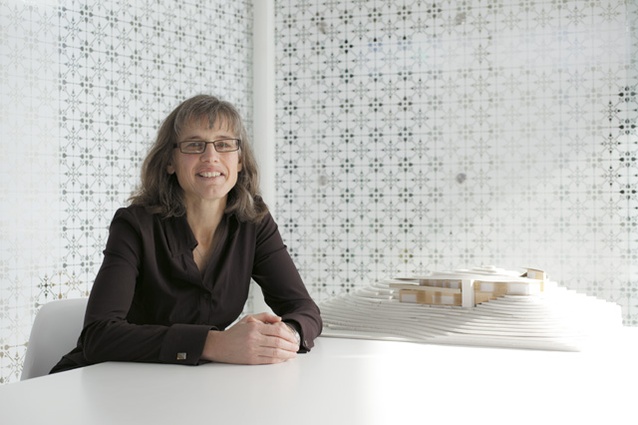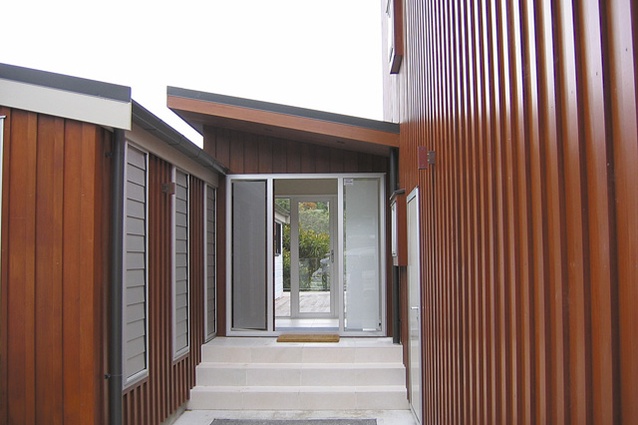Megan Rule of South Pacific Architecture
Where did you grow up Megan?
Southland. We started off in the lower reaches of the Mataura River, then we moved to central Southland and later to the upper reaches of the Mataura River.
Your parents were farmers?
Yes.
You weren’t tempted to go into farming?
I am still being tempted by them, but seeing what a challenging life it was, I don’t think it was where my natural inclinations were. But it certainly was a great environment to grow up in.
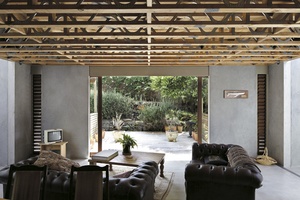
Did you want to be an architect when you were growing up?
Yes, right from when I was in primary school. of course at that age I didn’t know what an architect was at all, but I remember a school project occurring and being completely fascinated with observing the construction work during breaks. on the farm there were a range of different projects that happened, house modifications and things like that. My mother used to draw sketches of house plans and I found myself following suit and experimenting with that kind of thing as well. As a consequence of that when it came to choosing what todo in high school I enrolled in technical drawing. I was really drawn to that side of things, although I guess our parents were encouraging us to go into something to do with economics or something along those lines, but it turned out that no-one went off in that direction. From fourth form I had decided that I was interested in pursuing that path. I ended up going to meet local architects during the holidays - my parents took me to visit them. I remember them asking me ‘what do you aspire to be?’ At that stage I didn’t actually know what that meant. I guess I just knew that I was interested in the environment so I got holiday jobs working in a couple of the local practices.
Where they all men in those practices?
Yes. Throughout my time there haven’t been many women in the practices that I’ve been involved with. The women in the practice were usually either receptionists or office women, but not in the drawing room. That was always blokes.
When you worked for those practices were there particular types of residential architecture that took your interest?
What I realised is that being a small provincial location, there was a limited palette of what architecture represented, and it wasn’t until quite some years later when I travelled overseas that my horizons about what architecture were really broadened. From that, I had quite a limited perception still. It was fairly conservative and traditional, the approach to design. I think maybe one of the local practices stood out a little bit more but there wasn’t a noticeable difference. They worked quite a bit with existing buildings, because the town hadn’t grown quickly. It was a very ambitious town planning layout that never really came to fruition so there wasn’t so much need for new buildings, but more adapting existing heritage buildings and that type of thing.
Were you encouraged to study architecture by your family, after the initial disappointment of your not having gone into economics?
They could see where my interests lay and they were encouraging me to follow what I was interested in. I found that my experience in offices made me more interested in pursuing the field rather than putting me off. The most challenging and testing aspect of it was that it wasn’t easy for me to get there in the first place. I did my intermediate study at otago university and I didn’t get accepted into architecture school. even the second time I missed out, but I got a last minute place when someone had pulled out and I was able to go in at that point. so that was great, just to get over that first hurdle was a major challenge. Having said that, I had in mind that I was already working, so I had set up an alternate route to get there. Whichever way it happened I was going to get there eventually.
So you weren’t going to be put off?
No. The other thing that was quite helpful was that a family tree book was published in 1980 and I discovered I had a great uncle who was an architect and his face beamed out from that. He was based in Auckland and my parents caught up with him and arranged to meet up one summer. For me that was quite a significant step because it reinforced the family connection and he continued to be a long time mentor and role model. I think it was really quite important to have someone around that was always encouraging of what I was doing. We built a long-term relationship over the years.
Was it because of that influence that you wanted to study in Auckland?
Well that’s where I got accepted. I was quite happy to study in Wellington as well, because there were only two schools at the time but Auckland was where I ended up and I’m more than happy with that.
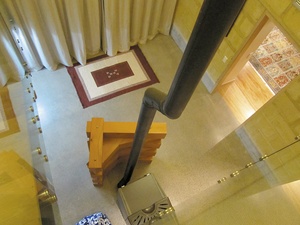
What was Auckland Architecture School like at that time?
It seemed to be in a major transition. I think they had just moved from being a three tier arrangement in the school to being across years. It seemed to be towards the height of de-construction and so there was huge emphasis on theory and playful architecture. I have to admit the first couple of years I was there were quite daunting and confusing. It was such a contrast to what I had been used to, which from an office environment was more pragmatic, practical; very ‘this is a building, put it together’. The school was more left field. Getting you to think about completely different ways of looking at things and less about how it might come into being I suppose.
Did you find studying architecture fun after all those years anticipating it?
In my first year I was on a real high from getting in, and then in my second year I had to figure out what was going on. It was quite a traumatic entry, not only was I shifting suddenly over a weekend with two bags, but the school had already started. on reflection it didn’t really matter but that transition felt really challenging. By the end of the second year I didn’t think I could complete the full course without traveling. I was itching to go overseas so at the end of that year I headed overseas for a couple of years and it was the best thing I could have done. I worked at a bigger practice in London and saw completely outrageous ideas of what architecture was and that really opened my eyes. By the time I came back for my final two years I had a clearer idea of what I was doing and what I wanted to do; and I wanted to enjoy it. I certainly felt the last two years were much more interesting.
So you lived in London?
Yes. I worked for a large practice and was able to go away for a few months and come back to the same practice and have continuity with projects which was really nice. I worked on projects when they were in the develop and design phase, and then I would come back and work during the contract administration phase on the same projects.
Did living overseas change the way you think about architecture?
I think that any experience I have had along the way has had some impact on my thinking on architecture. Certainly living in a big city and seeing the dense growth and the issues with moving around and transport; I can see parallels with what’s happening in Auckland at the moment. Growing pains and adjustment to densification is an interesting on-going issue that I guess we need to look at today. I had another trip that was quite significant in influencing what I was interested in. In 1995 I did a summer study school in Italy. It was based in a monastery with a bunch of students from different parts of the world. I found that mix of a different location, the experience of the historic city and learning about the layers over time and that evolution, has also influenced my thinking about how density starts to work. As a response to the solidity of buildings
Is that because we are such a young country?
We have had a different material base. New Zealand was full of trees, of course there’s a lot less of them now because they’re in our buildings. In those countries they used the resources they had at hand at the time. Partly what we are influenced by is the availability of local resources but also the ground condition. Clearly in New Zealand that has some influence on t he materiality of our buildings as w ell, and perhaps the timber structure has a better resilience to adjusting to our less st able ground condition. I guess that’s something that we are always learning more about as well. At the same time we do have our geological resource at hand as w ell, be it earth, stone or materials in the ground that we can utilise as well so it seems a shame to ignore them.
Was there anyone at architecture school that influenced your studies?
In my third year I did studios with sarah Treadwell and Mike Austen, and in my final year I worked with sarah Treadwell. That had a huge impact on my perspective on architecture and the whole process and also gave me a role model as well. I guess at the time she was the only full-time woman on staff.
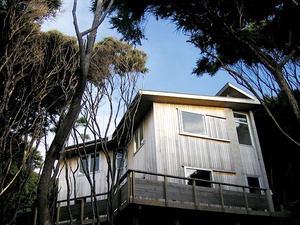
Did you get a job straight out of university?
Yes I managed to do that. It was quite fortuitous that I went overseas because that delayed my graduation for a couple of years. At the time I graduated it was getting towards the end of a recession like we’ve got today and so it seemed that amongst the students there wasn’t much motivation to look for work because there was a perception that there wasn’t much going. I was highly motivated to get work and I shortlisted five practices that I’d like to work for. one of them was advertising for a graduate so I put my application in and and I managed to get that job, so I was pretty happy.
What was the name of the practice?
Patterson Co-Partners Architects.
You went on to work for them for quite some time?
Yes, I was there for five and a half years. For me that was quite an exciting practice to work with. There were always really interesting projects to be done and it was very busy. There was lots of challenging work and juggling some interesting designs. In my early days working there we were working on the Axis building. I got to work in the area of the courtyard and the design of that, and of course that really overlapped with my interest in landscape and building interface; exposure of materials and structure and that sort of thing so it was aligned with what I was really interested in.
How did you decide to start your own practice?
I’ve always taken the approach that I am wanting to learn and if I get to the point where I’ve stopped being challenged then I want to move on to the next step. so that was a natural progression. At the time I was feeling quite worn out so I took time to have a bit of a break and then gradually started from there. so it wasn’t like an obvious decision of ‘let’s go start a practice next week’. It was ‘I am going to take time out and then see what happens’. It has kind of evolved rather than been a conscious sort of thing.
What were the goals for your practice when you set it up?
I’ve always wanted to do work that was beyond the ordinary, to push the boundaries and to begin to innovate. I am interested in progressing what architecture is rather than working on it as something that is doing more of what already exists. I want to look at how something can be done better or differently or evaluate; ‘this is the way it is being done, but can it be done differently?’ In some ways it possibly puts more pressure on oneself to think of it like that because it’s a bit more demanding than saying ‘this is what I’ve learned; now I’ll apply it’.
What are the things you enjoy most about being an architect in business?
I suppose it’s that you can choose your own direction in terms of where you want to take your practice, although I am sure you could do that as part of a group as well. Before I moved into this office I was in a collaborative - I was there for almost ten years. Which in a lot of ways was like an informal practice and I guess I was hesitant about going into it to begin with but on reflection it was actually a really nice collegial thing to do and it meant that you had the advantages of independence and also a bigger practice kind of sharing of resources and knowledge. It gave you the best of both worlds. Now I’ve moved into another shared office situation and I think there’s an advantage in that as well in terms of that shared environment.
What are the challenges of running your own practice?
I think as a very small practice one of the biggest challenges is spreading yourself too thinly in the roles that you play. sometimes in a bigger practice you have other specialists that you can bring in to lend support and advice or information, whereas in a small practice you need to go outside your office to consultants for that sort of thing. As a small practice you probably tend to work longer hours while you trying to juggle all these things. I am at a crossroads with regards to the workability of that. on the one hand it can be quite enjoyable, but it can be quite demanding as well.
Do you work mainly on residential projects?
I have been conscious in wanting to do a range of work so I’ve got involved in working on school projects and I am also interested in community projects as well. one of my early projects was a chapel project. I really enjoy working with small community groups and working through that whole thing of what exactly is the brief? To me it’s the most important thing, that beginning, ‘what exactly are we wanting here?’ sometimes it’s not even about the whole building, it could be something much less than that so it’s working through the briefing process that I think is vital. I have recently been involved with a marae project as well which I guess I wouldn’t have thought that I would’ve got involved with, but it’s been really enjoyable and interesting, and you meet a group of really wonderful people.
You have guest lectured at Auckland Architecture School. What was the subject?
Those talks have been around architecture and theory, and talking about my work and my thinking behind that. It’s very much the practical; ‘this is what my project is, this is how I design, this is what my thinking is’. I have also been involved in supervising some of the masters students and teaching studio programmes occasionally as well. I enjoy that involvement with students, it’s really nice.
Do you think the school has a more practical approach now than at the time that you were studying?
Yes definitely. I have seen it evolve from a very playful deconstructive type of work when I was there. some years ago the computer started to generate the design in its own playful way and I think it’s moved on from that to have a stronger emphasis on how a building might go together and also an interest in models and actually drawing a mixed media, multi-levelled approach to design. Certainly in the projects that I have been involved in I have really emphasised model making as a really useful tool to help understand the design.
You were on the NZIA awards jury in 2005 and 2006. Did you enjoy this?
Yes, it’s really nice to share that experience with other architects and you feel privileged to be able to see other work and meet clients who are enjoying their projects. Also meeting other architects who have found that they are very satisfied with their projects. It’s great.
Do you think that peer review is an important part of practising architecture?
I think it is valuable because our peers are also educated in understanding different perspectives on architecture and having discussions and critiques with your work sharpens it and helps you to evaluate it. It’s also important to have dialogue with laypeople because they also have some practical and pragmatic views on things and you have to be able to decipher that, so it’s not strictly isolated to other learned practitioners but also to the people who want to be in the spaces and working with them.
What are your aspirations for your practice?
I have always seen architecture as a progression or an evolution of building. You tend to start with smaller projects and then as your knowledge base becomes more sophisticated you become involved in more sophisticated projects; maybe in a larger scale, maybe in a more complex scale. so I’m interested in evolving into that and adding to the spectra. I am interested in a better environment for people. Whether that means less building, or the right kind of building. I have been particularly interested in a more global perspective on design where the bigger relationships fit into the environment. Recently I have been involved in a role in the environmental group within the institute. I had a loose involvement with that over a number of years that was mainly driven by a desire to understand that whole area better for my own learning. In the last couple of years I have thrown myself into that area, and I have found that it is extremely challenging to balance the concerns of the environment with what we’re building in it. What I have learned from this experience is that it can come back to the simple idea that good design and environmental design is about good stewardship of our built environment. What form that takes will be different for different people, but it’s more of a culture of attitude, and how you approach something as much as the final outcome. I think we need to be open to being aware that things are a bit more organic and each situation is different and requires a different approach or outcome. so I guess I am in favour of less constraints and more sensibility about our approach to what we are doing.

